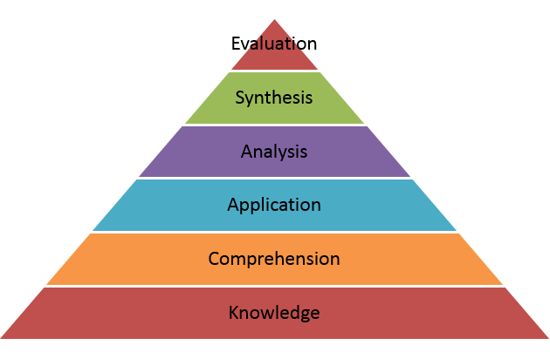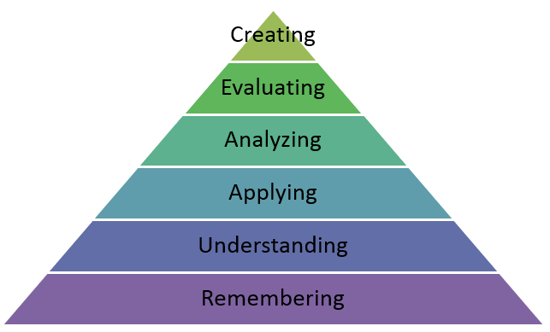Blooms Taxonomy: The Science of Learning Objectives – Part 1

In my previous blog, Learning Objectives – What They Are and Why You Need Them 1, we saw what a learning objective is and why it is important to frame good learning objectives. We have also seen that a good learning objective comprises three aspects viz. performance, condition, and criteria. In this post, we will look at Bloom’s taxonomy, which provides the basis for defining the performance aspect of learning objectives accurately.
Educational Psychologist Dr. Benjamin Bloom identified 3 domains of learning that are required to improve performance: Cognitive (Knowledge), Attitude (Affective), and Skills (Psychomotor). Dr. Bloom developed a taxonomy of learning objectives for each of these domains. Over the next few weeks, we will take a closer look at the taxonomy for each of these domains.
He defined learning objectives at six levels for the Cognitive domain.

Later, Prof. Lorin Anderson, a former student of Dr. Bloom, suggested revisions to this model. Prof. Anderson’s model focuses on the tasks performed at each level of cognition, rather than the outcomes. Another important change proposed by Prof. Anderson is moving the fifth level of cognition to sixth and vice-versa. Here is a representation of the revised model.

This week, I will review the first two levels i.e. Remembering and Understanding and provide examples of learning objectives written for these levels for 6 different types of training viz. sales training, product training, service technician training, software training, safety training, and social media policy training.
Let us now look at the Remembering level.
Remembering Level
At this stage, the learner must be able to remember and recall information that he has acquired previously. Examples of learning objectives at this level are:
- The learner would be able to mention the safety rules from memory.
- The learner would be able to quote the price of the lathe machine.
The verbs commonly used to frame learning objectives at this level are as follows.
- Select
- List
- Name
- Define
- Describe
- State
- Label
- Identify
- Locate
- Recognize
Understanding Level
The learner, at this stage, must be able to understand the meaning of the information and state it in his own words. Examples of learning objectives at this level are
- The learner would be able to explain the process of adding a macro in an MS-Word document.
- The learner would be able to restate the principle of congruence in his own words.
Here are some of the verbs commonly used to frame learning objectives at this level.
- Match
- Restate
- Paraphrase
- Rewrite
- Give examples
- Express
- Explain
- Defend
- Distinguish
- Interrelate
- Interpret
- Relate
Note: It is important to remember that the learning objectives need to reflect the mental processes taking place at each level and verbs are merely used to indicate the learning outcomes of the processes. In some cases, the same verb can be used to indicate the outcomes of mental processes involved at multiple levels. For instance, the verb identify can be used at the Remembering as well as Analyzing levels. Consider the two learning objectives.
- The learner would be able to identify the parts of a machine.
- The learner would be able to identify the root cause of the machine’s breakdown.
In the first objective the word identify is used to indicate the learning outcome of the mental process taking place at the first level of cognition (Remembering), while in the second it is used to indicate the result of the mental process taking place at the fourth level (Analyzing).
We will now look at a few examples of learning objectives written for these levels for 6 different types of training. sales training, product training, service technician training, software training, safety training, and social media policy training.
| Training | Objective at the Remembering level | Objective at the Understanding level |
| Sales Training | The learner would be able to list the steps in the sales process in order. | The learner would be able to explain the consequences of not following the sales process. |
| Product Training | The learner will be able to state the features of the product. | The learner would be able to explain how the product meets the needs of the buyer. |
| Service Technician Training | The learner would be able to label the parts of the product. | The learner would be able to match all the possible causes to the problem of car battery charge failure. |
| Software Training | The learner will be able to organize the steps to create a pivot table using MS-Excel in order. | The learner would be able to distinguish the option “Save” from “Save As”. |
| Safety Training | The learner would be able to identify the rules of fire safety. | The learner would be able to give examples of consequences of non-compliance of prescribed fire safety procedures. |
| Social Media Policy Training | The learner would be able to identify potential violations of social media guidelines, while posting information about a client on LinkedIn. | The learner will be able to match possible consequences to the violation of guidelines pertaining to posting of financial information on social media. |
Bloom’s taxonomy has grouped various verbs, which can be used to describe what the learner will be able to do, under the six levels of cognitive domain. In my next post, we will look at the Applying and Analyzing levels. So, stay tuned.
[1]CommLab India





